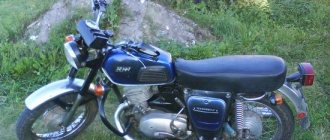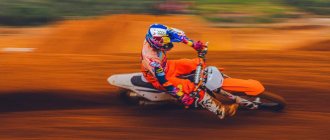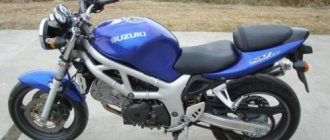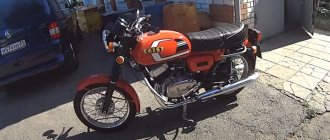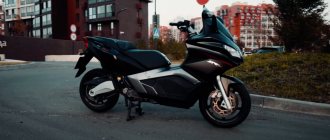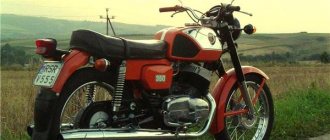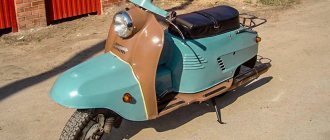Story
The first Java model, produced under license from Wanderer from 1929, had a four-stroke engine with a cylinder capacity of 500 cm3, was quite complex, expensive and was not in demand. Success for the brand came with the development in 1931 of a light motorcycle with a two-stroke engine with a cylinder capacity of 175 cm3. In 1934, a four-stroke Java with an engine capacity of 350 cm3 was mastered, then a two-stroke with an engine capacity of 250 cm3. In 1937, production of the Java-Robot motorbike began.
After the occupation of Czechoslovakia in 1938, the plant came under the control of the German authorities and began producing military equipment. However, the development of new motorcycle models on it continued. By the end of 1944, the company had prepared for production new models of motorcycles with two-stroke engines of 250 and 350 cm3 and a spark plug rear suspension designed by DKW.
After the liberation of Czechoslovakia, the plant was nationalized and resumed motorcycle production in May 1945. In 1946, the new Java 250 model created a sensation at an exhibition in Paris, winning a gold medal. For its smooth ride, the motorcycle received the nickname “Perak” (springy).
In 1953, production of a new family of Java motorcycles with two-stroke engines of 250 and 350 cm3 and a pendulum rear suspension was launched. The motorcycles were produced jointly with another Czech company CZ.
In 1970, production began of a new series of Java 250-623 and 350-633 motorcycles, distinguished by their original design. The motorcycles had a backbone frame and an engine with a separate lubrication system. In 1973, the Java 350-634 model with a duplex closed frame and a new engine went into production. The production of motorcycles with an engine capacity of 250 cm3 ceased. After modernization in 1984, the model received the index 638 and continues to be produced with minor changes. The total number of Java motorcycles produced in the 80s exceeded 3 million units.
The Java-India joint venture under the Ezdi brand has produced the Java-250 model since 1960, and the Java-350 model since 1983.
After the collapse of the CMEA, the production of Java motorcycles decreased sharply, but the company managed to stay afloat and maintain the production of motorcycles of the original design. The range of models has expanded to include motorcycles with more powerful Rotax and Honda engines.
Repair and tuning
All Soviet-era equipment, even imported, is distinguished by its simplicity of design. This is both good and bad. Maintainability in this case goes hand in hand with outdated technologies, which these days are not used even by Chinese and Indian motorcycle manufacturers specializing in extremely low-cost equipment.
Repair
Who will drag Java 350 to the service? Such motorcycles are repaired in the garage, with love and strong words when something doesn’t work out. But seriously, even an inexperienced motorcyclist can understand the design of a Czechoslovakian bike, because it is extremely simple. The wear resistance of some components is low, but they are very easy to repair or replace.
Spare parts
It is very difficult to find original spare parts for a model that was discontinued a long time ago, and you only need to look for it on message boards, owner forums, and so on. They are almost never sold in stores, although there are Chinese analogues of unknown quality. However, they are still not suitable for restoring a motorcycle to its original condition.
Tuning
In the past, this bike was often tuned, especially in rural areas, but now it seems blasphemous. Such motorcycle equipment, which has survived to this day, needs to be carefully restored, and not turned into a traveling exhibit of the “Collective Farm Tuning of the Year” exhibition. And those who do not agree with this, and intend to turn an old Java into a “chopper type” or “sportbike type” with the help of an angle grinder and a sledgehammer, need to be beaten for a long time and thoughtfully with an adjustable wrench until they realize the fallacy of their intentions.
Motorcycle in the USSR
The USSR was the main importer of Java. In total, more than a million motorcycles of various models were delivered to the Soviet Union.
The constant problem with purchasing spare parts was solved to some extent with the help of orders through Posyltorg.
The last Java model supplied to the USSR in the late 1980s and early 1990s was the Java 350-638. The first Java 638 appeared in 1984 and bore the index 5. It was similar to the model 634-7. The differences were a new engine, 12-volt electrics, and a new front fork. The front wing was painted red, and the rear wing was painted black. The 634th model had wings painted light gray. Also on the instrument cluster, the neutral light is green. The tachometer received a green scale (Economic).
In 1986, Java 350-638-00 appeared, for the characteristic shape of the rear part it was also called “Pencil”. It was also called “Banana” or “Squirrel” because of the rear spoiler. In 1989, Java 350-638 appeared with the index 1-03, which received the popular name “Lux”, “Super” and “Stub”. It was distinguished by longer exhaust pipes and, accordingly, a larger bending radius, which led to the effect of raised mufflers. The mufflers themselves became shorter in length (like the model 634) and received dents on the inside in the area where the shock absorbers were installed, and the upper mount of the rear shock absorbers on the frame changed. Also, stickers took the place of the metal nameplates located on the gas tank and side covers. In the same year, model 638-1-04 (Twin Sport) appeared, with different decals and Cezet shock absorbers.
Design
Not a single biker born at least 30 years ago will confuse this model with any other. The recognizable silhouette with an abundance of chrome and a long, flat seat, a seemingly chopped off taillight and matte aluminum engine covers sunk into the soul of many of us even in childhood or adolescence. The Java 350 differs noticeably from Soviet bikes in being less heavy and more graceful.
Motorsports
Java motorcycles have successfully performed in sports, in particular in motocross and six-day Enduro competitions. Particularly significant successes were achieved in speedway and ice speedway. In the 60-70s of the 20th century, Java motorcycles with four-stroke engines were among the best speedway motorcycles in the world. They were attended by multiple speedway world champions Barry Briggs, Ivan Mauger, Ole Olsen and many other athletes. On Java motorcycles, Soviet and Russian racers Gabdrakhman Kadyrov, Sergei Tarabanko, Anatoly Bondarenko, Nikolai Krasnikov and others repeatedly became world champions in ice speedway. The Russian national ice speedway team continues to use Java motorcycles.
Advantages and disadvantages
The Java 350 needs to be compared with contemporary motorcycles, and not with models produced today. And for its era, this bike was, without exaggeration, magnificent! It was not for nothing that it was so popular in the USSR, despite the fact that Soviet motorcyclists had to order spare parts for it from the allied Czechoslovakia using various tricks.
Advantages
- Power . All sorts of “Voskhods” and “Izhi” could not compete with the Czechoslovak motorcycle on the road.
- Significant service life of the engine and CPG , noticeably longer than most Soviet bikes.
- Moderate mass , less than that of the Ural or Jupiter.
Flaws
- Difficulty finding spare parts these days. You can find everything, but you have to run.
- Compared to modern competitors, Java 634’s technical characteristics cannot stand any comparison even with the “Chinese”. The 638 model, however, does the same.
- It’s simply a pity to use the completed Java 350 as a vehicle for every day.
Conclusion
Comparing the Jawa 350 motorcycle with modern bikes is incorrect and even unfair. In terms of technical characteristics, this model, developed half a century ago, is inferior to any motorcycle that can be bought in showrooms now, even Chinese. But for their time, the Czechoslovakian steel horses were magnificent, and many motorcyclists have the warmest memories of them. If, when you look at this recognizable silhouette, nostalgia rolls over you, and you want to lock yourself in the garage and start servicing this greeting from the last century, then it’s worth buying it to pamper yourself. The completed Java 638 will become not only an excellent toy for real men, but also just a good weekend motorcycle.
Specifications
| Maximum engine power: | 26 HP |
| Working volume: | 350 cm3 |
| Motor type (cylinder arrangement, number of strokes): | 2-cylinder, 2-stroke |
| Number of cylinders: | 2 |
| Number of valves: | |
| Intake type (Injector / Carburetor): | |
| Bore and stroke: | |
| Starting system (Electric starter, kick starter): | |
| Maximum speed in km/h: | 130 km/h |
| Cooling system: | Air |
| Transmission (gearbox): | 4-speed |
| Clutch (Dry / Wet): | |
| Drive unit: | Chain |
| Frame: | Steel tubular |
| Chassis | |
| Suspension (front/rear travel): | |
| Brakes (Front/Rear): | |
| Wheels / Tires / Rubber: | |
| Dimensions and weight | |
| Dimensions (Length / Width): | |
| Seat height: | |
| Ground clearance: | |
| Curb weight: | |
| Wheelbase: | 1335 mm |
| Weight: | 156 kg |
| Fuel tank capacity: | 17 l. |
| Battery capacity: | |
| Year of release: | |
| Country of Origin: |
Similar models
- Izh Planet 5. An excellent motorcycle for its time, quite powerful and unpretentious.
- Izh Jupiter 5. The characteristics are similar to the above-mentioned brother, but differs from it in having a 2-cylinder engine instead of a 1-cylinder.
Owner reviews
In my youth there was such a device, I don’t remember the year of manufacture, I never had any documents, but I drove it in the 90s, and even then it was far from new. With Java, I was always the first guy in the village)) This is not Minsky with Voskhody... The horse is fire! On the highway it can easily go over a hundred, but if desired, it can also rush along an intersection normally if the tires are adequate. As far as I remember, it didn’t break much, except that the carburetor had to be adjusted again from time to time, something was wrong with it. But still, the spendthrift is a legend! Arthur, Nizhny Novgorod.
Last year I bought myself an old Java for restoration, the seller gave me 634 not running as a load, so I’m doing a little of both. The old woman is already on the move, I’m slowly finishing 634, bringing it to mind. It’s difficult to find original spare parts, but I don’t want to install non-original ones, the goal is to restore it to collectible condition. I am pleased with the very simple and well-thought-out design; compared to modern motorcycles, the difference is huge. Evgeny, Lipetsk.
I still ride this motorbike; it is parked at the dacha and spends the winter there right in the barn. In the city of Golda-poltorashka there is, 180 km to the dacha, but there are no asphalt animals around there at all, the goldolet on local roads is only ruined, so I drive there in Java when I arrive. The moped is indestructible; after wintering in a snow-covered shed, it always starts, you just need to charge the battery and throw in fresh gas. Previously, they knew how to make real equipment)) Dmitry, Ryazan.
FAQ
- Do the spare parts for 634 and 638 fit together? For the most part, yes. But parts for a more recent model, that is, 638, are more often found on sale.
- How many horses are there in Java 350? Exactly 26 fast horses. True, no one remembers exactly how the Czechoslovak plant measured power, at the crankshaft or at the rear wheel.
- I have an old anniversary car in my garage, I got it from my grandfather, it hasn’t started for about twenty years, but it looks decent. Does it make sense to invest in restoration for the purpose of selling? Yes, if the bike is in overall good condition. Collectible pieces can be quite expensive.
- What is the lifespan of this motor? There is no exact data, but there are reviews from owners who claim that the engine runs 30,000 km or more without repairs.
- How much does the Java 350 motorcycle weigh? Curb weight with all fluids and other things is about 185 kg, dry weight is about 156 kg.
Technical component
Now about the technical part. This motorcycle had a classic design .
The frame was a tubular carrier, and all the elements were attached to it. The front suspension consisted of a front telescopic hydraulic fork.
At the rear there is a pendulum with two shock absorbers. The braking system is completely drum, with a cable drive at the front and a traction system at the rear.
The power plant is a two-cylinder, two-stroke, in-line arrangement. Cooling is air, and the power system is carburetor. The power plant was started by foot.
The gearbox was foot-switched and had 4 speeds. The drive to the rear wheel was carried out via a chain drive.
The motorcycle was simple in design, but precisely because of this, and even with its spectacular appearance, it was a desirable vehicle for many.
Video
The motorcycle we are disassembling today has good driving characteristics.
The hero of this video shows us how to drive a Java-650, both on a city highway and on rough terrain. Did you like the article? Tell your friends!
Comments (1)
- Andrey:
09.22.2016 at 13:06In the video JAWA 634th
Answer
